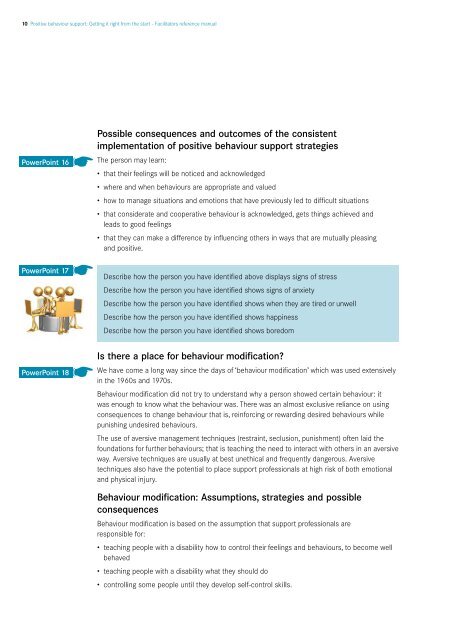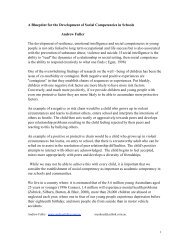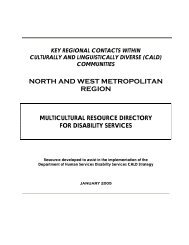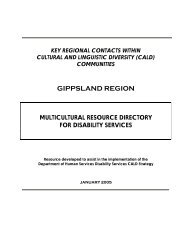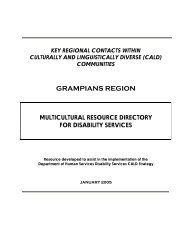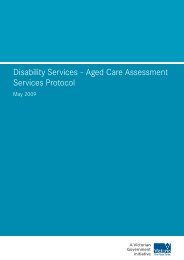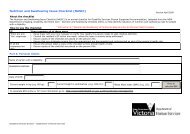Positive Behaviour Support - Department of Human Services - Vic ...
Positive Behaviour Support - Department of Human Services - Vic ...
Positive Behaviour Support - Department of Human Services - Vic ...
You also want an ePaper? Increase the reach of your titles
YUMPU automatically turns print PDFs into web optimized ePapers that Google loves.
10 <strong>Positive</strong> behaviour support: Getting it right from the start - Facilitators reference manual<br />
PowerPoint 16<br />
PowerPoint 17<br />
PowerPoint 18<br />
*<br />
*<br />
*<br />
Possible consequences and outcomes <strong>of</strong> the consistent<br />
implementation <strong>of</strong> positive behaviour support strategies<br />
The person may learn:<br />
• that their feelings will be noticed and acknowledged<br />
• where and when behaviours are appropriate and valued<br />
• how to manage situations and emotions that have previously led to difficult situations<br />
• that considerate and cooperative behaviour is acknowledged, gets things achieved and<br />
leads to good feelings<br />
• that they can make a difference by influencing others in ways that are mutually pleasing<br />
and positive.<br />
Describe how the person you have identified above displays signs <strong>of</strong> stress<br />
Describe how the person you have identified shows signs <strong>of</strong> anxiety<br />
Describe how the person you have identified shows when they are tired or unwell<br />
Describe how the person you have identified shows happiness<br />
Describe how the person you have identified shows boredom<br />
Is there a place for behaviour modification?<br />
We have come a long way since the days <strong>of</strong> ‘behaviour modification’ which was used extensively<br />
in the 1960s and 1970s.<br />
<strong>Behaviour</strong> modification did not try to understand why a person showed certain behaviour: it<br />
was enough to know what the behaviour was. There was an almost exclusive reliance on using<br />
consequences to change behaviour that is, reinforcing or rewarding desired behaviours while<br />
punishing undesired behaviours.<br />
The use <strong>of</strong> aversive management techniques (restraint, seclusion, punishment) <strong>of</strong>ten laid the<br />
foundations for further behaviours; that is teaching the need to interact with others in an aversive<br />
way. Aversive techniques are usually at best unethical and frequently dangerous. Aversive<br />
techniques also have the potential to place support pr<strong>of</strong>essionals at high risk <strong>of</strong> both emotional<br />
and physical injury.<br />
<strong>Behaviour</strong> modification: Assumptions, strategies and possible<br />
consequences<br />
<strong>Behaviour</strong> modification is based on the assumption that support pr<strong>of</strong>essionals are<br />
responsible for:<br />
• teaching people with a disability how to control their feelings and behaviours, to become well<br />
behaved<br />
• teaching people with a disability what they should do<br />
• controlling some people until they develop self-control skills.


